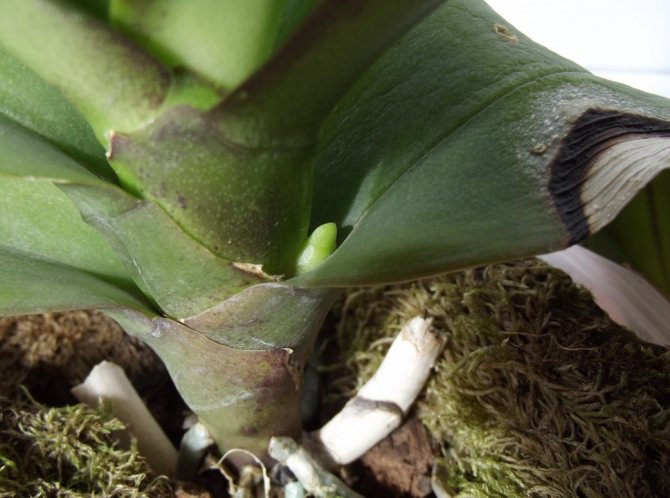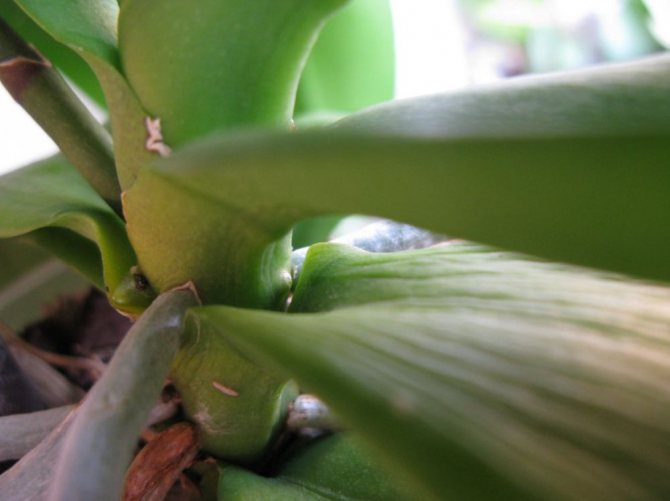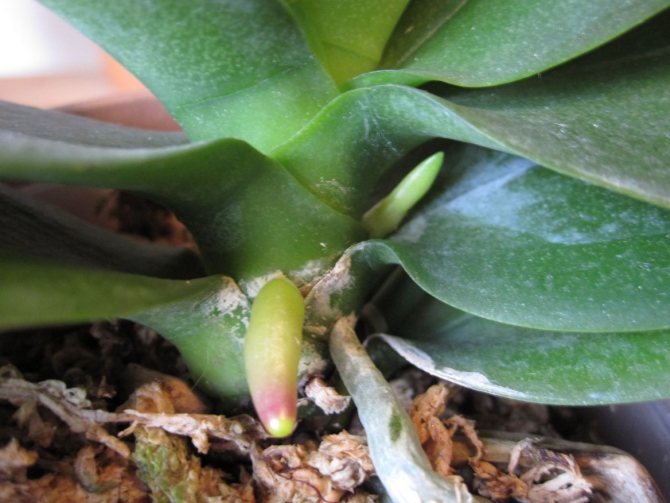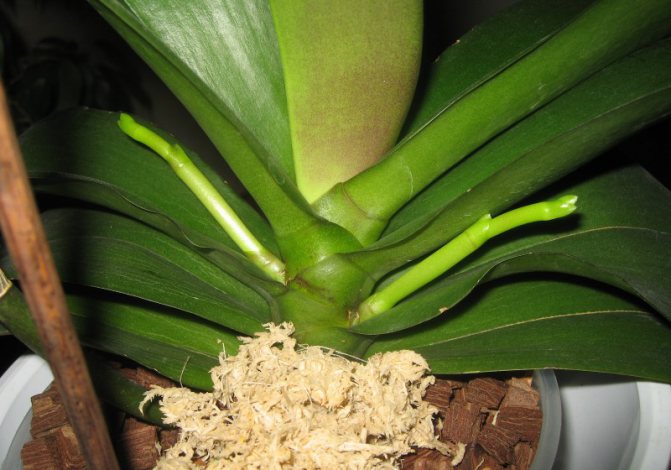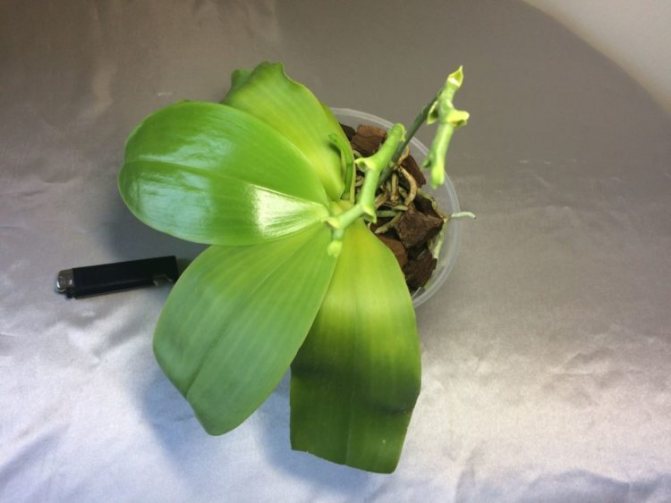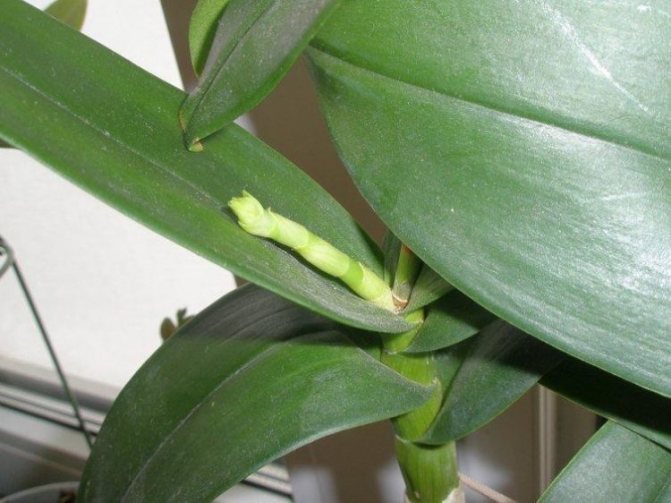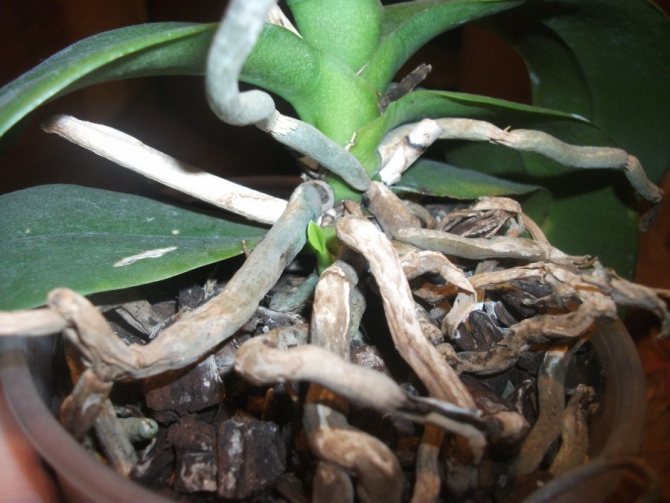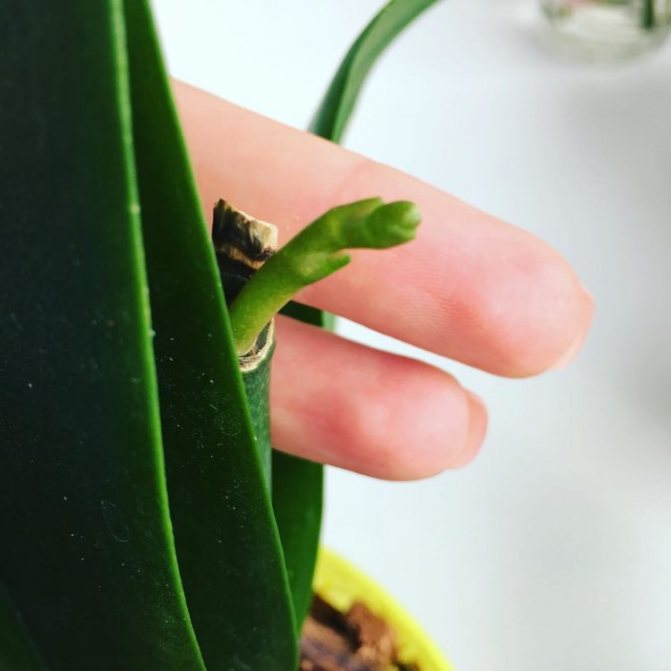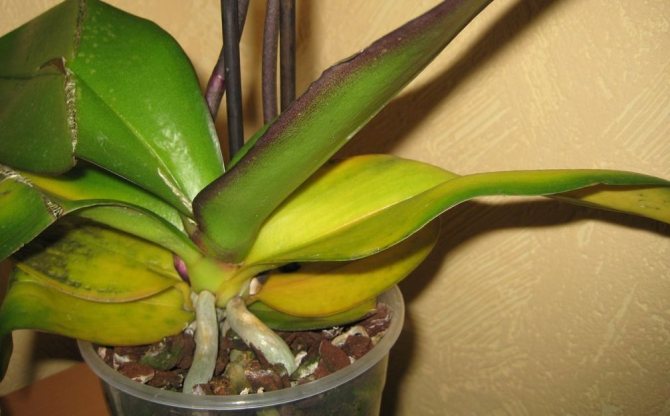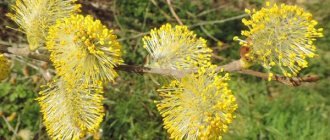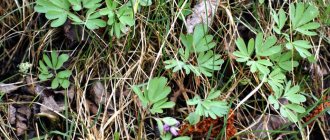My orchid has been growing for 3 years already. When they gave it to me, I could not even imagine that such a beautiful and exotic plant would take root in me and begin to bloom regularly. And now the moment has come when I can show and tell all the stages of orchid growth and share my personal experience of growing it.
- Phalaenopsis Orchid
In Russia, orchids are no longer news, and nevertheless, there is not a lot of reliable and detailed information about them. When I started looking for information in flower shops and on the Internet, I had to collect it bit by bit. Not infrequently, I have come across conflicting articles and descriptions. Some of these descriptions I immediately dismissed, understanding their obscenity, but I adopted something.
- Here is my phalaenopsis orchid:
At the moment, it doesn't look perfect due to my mistakes. But there is something to show how not to do it.
The first mistake I made - did not choose a suitable pot for the plant and replant. The orchid did not grow badly without transplanting in a standard plastic cup. But this is very inconvenient. Orchid leaves are fleshy and very heavy. Between watering, the soil dried up and the plant fell on its side several times due to the weight of the leaves. In general, this did not affect the development of the orchid, but several beautiful leaves were broken off.
The second mistake I made - put the orchid on the windowsill on the sunny side. All my windows face one side, so there was no choice where to grow the orchid. Any plant needs light, but the orchid is very susceptible to sunburn. Literally, one day the sun burned an orchid leaf.
Fortunately, the sun managed to burn only one leaf, but the appearance of the whole plant is again spoiled. To avoid such burns in the future, I glued tracing paper to the window, which protects the plant from direct sunlight.
About Orchid Transplant:
To transplant an orchid, you do not need to wait until the end of flowering. My orchid blooms continuously, so you won't get a dormant period.
When I realized that my orchid is growing and developing, regardless of whether I want it or not, I began to look for a suitable pot for it. Surprisingly, even in flower shops, workers are not always in the course on how and in what to grow orchids correctly. Fortunately, I came across a review of the special Korona pots. The essence of this pot is outrageously simple. It consists of numerous plastic sticks that support the soil but allow the root system to breathe.
You can buy a special soil for an orchid or make it yourself. As a soil, many people use pine bark soaked or boiled in boiling water. You can also make a mixture of coconut substrate and soil. There are a lot of options, which one is the most suitable, I have not yet decided.
- How to distinguish new sprouts from aerial roots in an orchid:
Waiting for the first peduncle, I watched with trepidation every neoplasm in the leaf axils. At first, it seemed to me that aerial roots are very similar to sprouts. Now I can distinguish even the smallest sprout from the root.
While searching the Internet for the difference between a root and a sprout in an orchid, I often came across this wording: "the roots grow down, and the sprouts up".This formulation is correct, but not precise. It often happened to me that the spine began to grow up and only then turned down.
In fact, the sprout is visually very different from the root. It is as green as leaves and has a stepped structure. The roots are smoother and more grayish.
I think that in this photo everything is clearly visible and understandable.
- Orchid babies:
Children are a new plant. Babies can appear in two ways:
1) They can grow on the mother plant:
My baby has 3 leaves, the first one is not visible in the photo. Whether it is possible to plant it without harm to it or the mother plant - I have not yet understood. Let it grow here.
2) Children can appear on the peduncle! Yes, yes, in an orchid, the peduncle serves not only for flowering. It is a multifunctional stem. And you shouldn't cut it "at the root" after flowering.
The peduncle is cut over the upper living bud. How to identify a living kidney or not?
This photo clearly shows how live and non-living kidneys look like. The non-living kidney is dry, light brown in color. A living bud is the same color as the stem.
From living buds, a new peduncle or a young plant, a baby, may appear. At the moment, one kidney has woken up and started to grow:
Unfortunately, I found out about such a feature of orchids not so long ago and chopped off a couple of peduncles at the root immediately after flowering.
In growing, the orchid is very unpretentious. I water it with clean water from the filter. I pour some water not as usual from above, but into the pallet. I haven’t bought any special fertilizers yet.
Thanks to its fleshy leaves and horses, the orchid tolerates dry soil very well. Even the most forgetful housewives will not have problems with watering.
The orchid blooms for a very long time. From the moment the peduncle appears to flowering, it can take 1-2 months. All the flowers can bloom one more month and they will stand for the same amount of time. Not a single houseplant is able to delight the hostess with its flowering for so long.
This is my beauty growing up. I hope you find my review helpful.
___❀___ ❀___ ❀___ ❀___ ❀___ ❀___ ❀___ ❀___ ❀___ ❀___ ❀___ ❀___ ❀___ ❀___
Thank you for your attention to the review! Best regards, Tanya.
~ ❤ ~ Subscribe to new reviews ~ ❤ ~
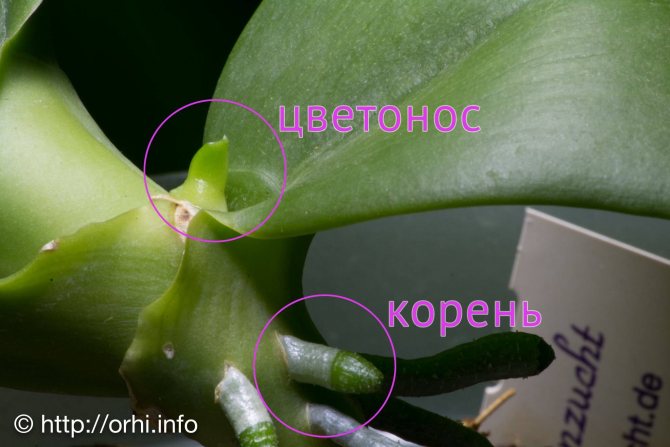
You have noticed that on your Phalaenopsis orchid, something has hatched above or below the leaf. You are bursting with joy and curiosity, but how to recognize what it is - a peduncle, root or root baby? Thanks to this article, you can easily determine what is growing with you!
Maybe this root? Can! The new Phalaenopsis root is likely to grow alongside other roots - under the leaves from the base of the trunk. Although the location of the root may be unexpected - in theory, it can grow from the trunk anywhere else. The growing root cuts through the leaves, breaking through them. The root is round and obtuse, perfectly smooth in appearance and without scales.
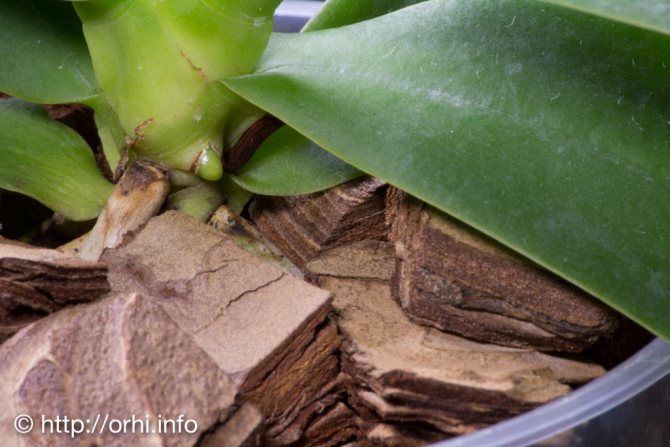

As you grow, you will clearly notice the difference in color between the tip and the rest of the root. The root itself will be gray-green or gray, and the tip will be bright green, light green, or pinkish. The root is usually directed downward, towards the ground and moisture, less often to the side or up.


Or maybe it peduncle (arrow)?! Maybe! The place of appearance at the peduncle (arrow) is more predictable than at the roots. The peduncle emerges from the leaf axils - the place where the leaf comes into contact with the phalaenopsis stem. Like the root, the peduncle breaks through the leaf.


In appearance, the peduncle is flat with a pointed tip, on it you will immediately see scales. The peduncle (arrow) has a light green or green color along its entire length. The peduncle usually grows upward - towards the sun or another light source.
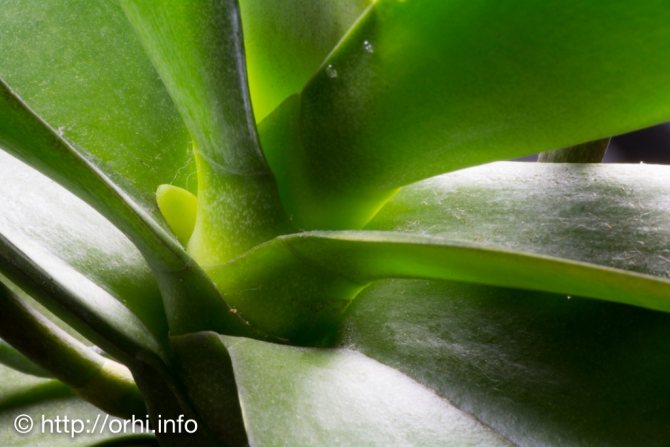

Or is it root baby? It is not excluded! The basal baby is easy to confuse with the peduncle due to the place of formation and visual convergence.Children also grow from the leaf axils, but they can hatch at the base of the phalaenopsis, where the roots grow. The basal baby has a sharp tip or oval shape, but over time it takes on the shape of a boat.


If your phalaenopsis has lost its growth point (the middle from which the leaf grows) or a peduncle grows from the growth point, I can assure you that you will soon have a baby.
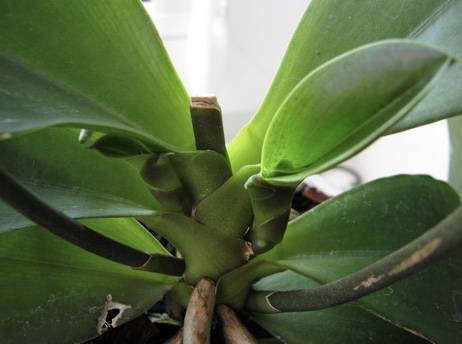

Although to the end it is impossible to be sure of anything. There are times when, by all indications, a peduncle grows, but the plant surprises, and the peduncle turns into a baby.
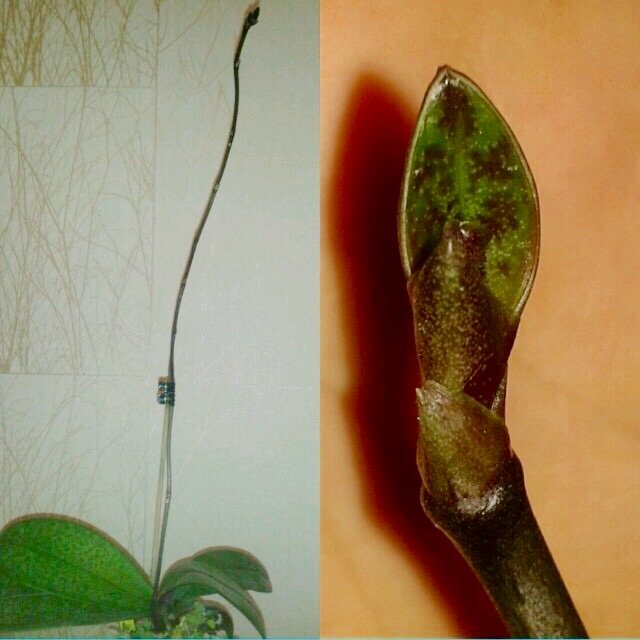

Get ready for the surprises of nature and rejoice at any sprout or spine!
How to distinguish a peduncle from a root in phalaenopsis?
Only at first glance, the roots and peduncles at the beginning of development are very similar, if you look more carefully, it becomes clear that they are completely different. What unites them will be that they both seem to break through the sheet when they appear.
Beginner florists these tips for determination will help:
- Look closely at the place where the flower stalks (supposed) grow from and locate them in relation to the growing point. If the neoplasm grows from the stem, is located on the root collar between the leaves, then this is a young air root. The arrow will grow differently;
- The second significant difference will be the direction of growth, the roots have a slightly downward sloping shoot. The peduncle has a different direction;
- They will also differ in color, the roots have a bluish-green color at the base, and the tip is usually bright green. The arrow has a single-color coating over the entire surface.
- The root has a smooth structure, and here the peduncle is divided from the very beginning by small scales, under which, with further development, dormant buds will be hidden.
- Other obvious differences are the tips of the sprouts; at the root primordium, it is rounded and blunt. The peduncle is characterized by a pointed end, and the body itself will be flat.
Appearance process
The appearance of a peduncle is always desirable, because what else can please a grower, if not a blooming stem on the windowsill.
With phalaenopsis in this regard, not everything is so simple: in order for the plant to begin to drive out the arrow, some effort is needed.
And now a tubercle appears between the leaves, it grows every day and finally breaks through the leaf plate on the stem. But how to determine for sure that this is a peduncle, and not just another root?


There are no difficulties in this, just take a closer look at the neoplasm... Let us consider in detail how a peduncle appears in phalaenopsis:
- the formation of arrows occurs in the axils of the leaves, or, to be more precise, between the leaf plates, usually where they are attached to the trunk;
- the growth of the arrow is carried out in the direction of the light source, the sprout stretches behind the sun or an artificial source in the autumn-winter period;
- the presence of scales will also help determine.
Every day the arrow will grow and develop more and more actively, as a result, very soon you will be able to admire the flowering of a tropical beauty on your windowsill.
Changing the containment condition when the arrow appears
When a flower branch appears, the content of the plant changes slightly. Primarily, it is placed closer to the light sourcebut not in direct sun. If it is autumn-winter time, then lighting with special plant lamps may be required.
Watering during the growth of the shoot remains at the same level, but we must remember that fertilizing is applied before the first bud begins to set.
At the moment of shoot growth, fertilizers will no longer affect the number of buds. The number of flowers is influenced by the care received by the plant before discarding the flower shoot.
Difference from root baby
Experienced flower growers know that in addition to roots and peduncles children can develop on orchids. Sometimes they appear on peduncles, but under certain circumstances, children can develop in other places.
One of these places is its root location.
The phalaenopsis arrow and the baby have one place of growth, they tend to develop from the leaf sinuses, and at the very beginning of development, they are visually very similar. It manifests itself in the form of an escape, and in color, and in the presence of scales.
The appearance of a baby, including a root one, is usually preceded by such indicators:
- complete absence of a growth point;
- instead of a sheet, an arrow went from the top;
- the plant is quite old, over 6 years old.
Each of these signs indicates that a baby will appear at the trunk in the near future. Moreover, the absence of a growth point is most often characterized by the appearance of a basal sprout.
But besides the similarity, these two neoplasms also have a number of differences. How to distinguish a peduncle from a baby:
- the similarity of the shape of the shoots at the very beginning of development is lost, the baby takes the shape of a boat, gradually a depression appears in the middle of it;
- his scales are much smaller, they hardly develop during the growth process;
- after a couple of weeks, the arrow will become longer, the baby will begin to release the first leaves.
Based on this, it will be possible to determine what grows in the orchid.
Pests and diseases
A diseased plant is unable to form an arrow. Among the main diseases affecting the peduncle are:
- Powdery mildew. As a treatment, the drug Skor or a solution of colloidal sulfur is used.
- Gray rot. A fungicide will help in the fight against it.
- Anthracnose. The disease is treated with the drugs Ritomil and Mikasan.
Pests can also cause the arrow to be missing. Common harmful insects are:
- Mealybug. The affected plant is treated with soapy water.
- Shield. For treatment, Actellik solution is used.
- Thrips. These insects are destroyed with Fitoverm.
Why distinguish between orchid root and peduncle
It is important to learn how to correctly determine what kind of sprouts appear on the plant. This can be a signal that he needs more careful care.
The orchid during the flowering period requires special care and requires special attention. From time to time, it needs to be fed with fertilizers and the irrigation schedule should be changed.
There are times when the plant should not be allowed to bloom. For example, if it hurt for a long time (roots began to rot) or recently underwent a transplant, and the adaptation period was difficult. In such cases, the best way out is to cut the stem of the peduncle, thereby preventing the plant from blooming. This will help the orchid conserve energy and use it to grow. Blooming requires a lot of energy from the flower.
Differences between root and peduncle
A peduncle is a long shoot on which orchid buds form. It grows both straight and taking bizarre shapes, for example, a spiral shape. It is distinguished from the root by a number of features.
Peduncle:
- sprouts at the base of a new leaf;
- has a sharp tip and stepped base;
- resembles a flat cone in shape;
- grows up, less often - to the side;
- if not tied up in time, it will begin to sink down under the weight of flowers.
Root:
- germinates outside or anywhere on the neck of the plant, even from the center of the leaf;
- has a bright brownish tip and a light base;
- smooth, without scales and primordia;
- is able to grow in any direction, but most often tends downward
Differences between a peduncle and an embryo
In addition to the roots and peduncles, orchids form the embryos of new flowers, or, as they are also called, "babies". They mainly appear on the pedicel, but there are times when they grow near the root of the plant. In this case, the embryo is just as easy to confuse with a peduncle.
At the beginning of development, babies have the same shape, a similar stepped stem structure and do not even differ in color. Some signs help to understand that a fetus has appeared:
- the sprout has no point of growth;
- a leaf appears instead of an arrow;
- the plant is more than 5 years old.
If you look closely at the process, in addition to the similarity, you can also see some differences between the peduncle and the baby. The shoots look the same only at the very beginning, as the peduncle grows, it stretches and grows upward, and the baby takes the form of a droplet with a characteristic depression in the middle of the shoot.
As it grows, the peduncle retains the stepped structure of the stem, while in the embryo, the scales are much smaller and do not develop during growth; after 10-12 days, the peduncle becomes longer, and the embryo releases 1 or 2 leaves.
It will not be difficult to distinguish the root of a flower from a peduncle if you know the characteristic features of each of the elements presented.
Peduncle growth characteristic
Some owners have some problems with growing orchids. One of the frequently asked questions is why the flower does not bloom for a long time. The reason may be improper care or uncomfortable conditions of detention. If all the requirements are met, phalaenopsis blooms several times a year.
It takes at least 2-3 months for the orchid to bloom. Of these, only 4-6 weeks are spent on the growth of the peduncle itself. Typically, flower shops sell plants with 2-3 flower arrows. However, when growing a flower indoors, their number may be different. How many there will be depends on the variety, microclimate and care.
Summarizing
An orchid is a tropical flower, so adaptation to unfamiliar conditions is not easy. If sprouts appear on the plant, it does not matter if it is roots or a peduncle: this means that the plant is full of strength and has fully adapted to its new place of residence.
If you treat the plant with love and care, carefully monitor its development and take care of it in time, it will delight the owner's eye with a magnificent beautiful flowering and an unusual aroma for a long time.
Care during growth
After all measures were taken for the germination of the rudiments and they began to appear, gardeners are thinking about how to care for such a miracle. The first thing to do is to provide comfortable conditions for the emerging flowers and the plant in general. After all, growing an orchid stalk is not as difficult as stimulating it to form flowers. In order for the orchid to grow healthy, be sure to apply fertilizer while the buds are forming.
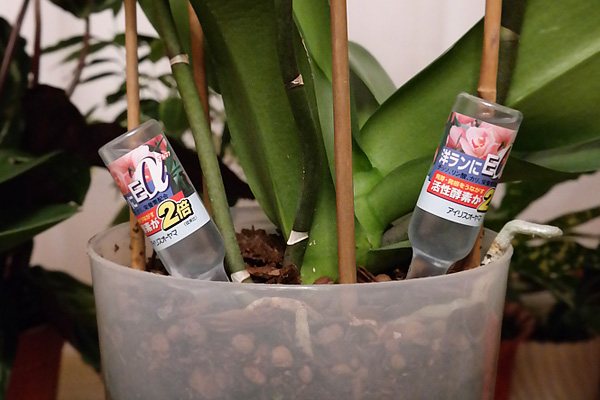

In order for phalaenopsis to bring beauty for a longer time, you can lower the average daily temperature by a few degrees, since in a hotter environment all phases of flowering pass too quickly.
Description of appearance
Unfortunately, on the territory of our country, the cultivation of indoor orchids is a completely new hobby. Orchids are beautiful and exotic plants for our latitudes, and many flower growers are concerned about what needs to be done during the period of peduncle growth. To navigate the flowering of such common types of indoor orchids as Cymbidium or Phalaenopsis, as well as less popular orchids, some features of this process should be taken into account:
- Orchid flower stalks often grow in the most bizarre ways. The peduncle can bend into a pig's tail, then begin to rise and grow upward. In addition, the peduncle can grow in any direction. While the flower stalk of a room orchid is growing, the grower should not touch anything. In no case should the plant be transplanted. It should be remembered that the peduncle always grows from the point of growth.
- As a rule, it is not difficult for experienced florists to distinguish flower stalks from the root, but an inexperienced florist cannot always immediately determine whether a flower stalk is growing in a room orchid or this part of the plant is a root.
- There is often a possibility that indoor orchids, after a short rest, and some types of orchids, will prolong the peduncle even without rest.
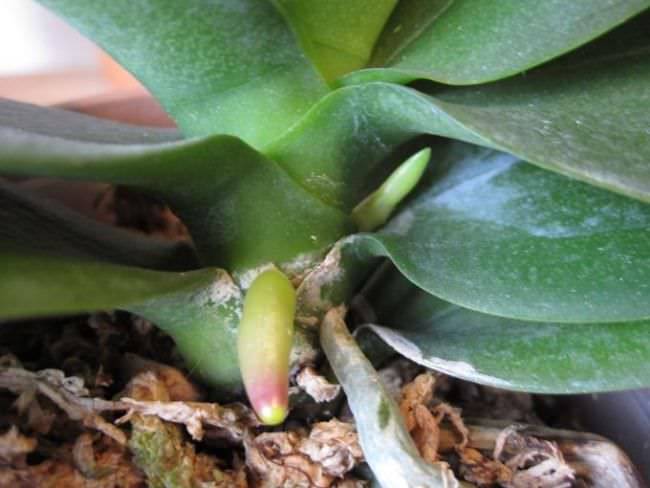

- The very beginning of autumn is the most favorable period for the flower buds of a room orchid to give rise to growth for new peduncles. This rule primarily applies to the species "Cymbidium" or "Phalaenopsis".
- If an indoor orchid simultaneously releases a peduncle and a new healthy leaf, then it is imperative that the plant make its own choice of what to develop further.
- Orchids from the "Phalaenopsis" species often have new leaves in summer or early autumn, and high-quality flower stalks are formed in late autumn.
- Long peduncles of Cymbidium orchids are known to many for their large flowers, which can often be bought in the cut. During the flowering stage, Cymbidium orchids should be kept in an evenly moist substrate, but not transplanted.
- Cymbidiums and Phalaenopsis are the most popular orchids today. Their reproduction is not difficult, and enchanting flowering can be seen in numerous photographs of amateur flower growers. "Cymbidiums" and "Phalaenopsis" are unpretentious not only at the breeding stage, but also undemanding to care.
Reasons for the absence of a peduncle
The conditions for keeping an orchid depend on the variety and age of the plant. However, there are general requirements for care, non-observance of which will lead to a deterioration in the vital signs of the flower. It is important to understand why the plant is not able to release the arrow.
Humidity level
Orchids grow in low humidity, but too dry air will prevent the plant from forming a peduncle. Due to a lack of moisture, the buds may crumble without opening. The moisture level depends on the type of orchid:
- Vandas bloom occurs at 70-80% moisture in the air during the day and 60% at night;
- Dendrobiums and Phlenopsis require 30-40% humidity;
- Cattleya produce a peduncle at 40-50% humidity.
Air humidity is lowered when the flower is stimulated by the temperature drop method. Otherwise, the root system will freeze and the plant will die.
Indoor light
Daylight hours for Phalaenopsis and Dendrobium should be at least 8 hours. In winter, the plant requires additional light sources. Special phytolamps are used for illumination. The amount of light required depends on the type of plant:
- Cymbidium produces a peduncle at 12 hours of light;
- Paphiopedilum requires 14 hours of light;
- Catleys grow with a daylight hours of 12 hours.
Lack of lighting affects not only the ability of the plant to form a shoot. Without the right amount of light, an arrow will appear, but the plant will not bloom.
Watering mode
The arrow appears after stimulating the plant with the drought method. But, being without water for a long time, the flower will die. Moisture-free orchids shed the frog, conserving water in foliage and roots. Watering phalaenopsis and dendrobium is carried out by spraying 1 p. in Week. One spraying every 10 days is enough for sympodial varieties. These include:
Temperature
Temperature is one of the main factors affecting the appearance of an arrow. The temperature drop method is the main way to stimulate the orchid. However, at low temperatures, the flower sheds its peduncle. The level of heat depends on the variety:
- Phalaenopsis will not form an arrow if the room is below 16 ° C;
- Dendrobium dies at temperatures below 14 ° C;
- Cattleya and Wanda can withstand drops of up to 10 ° C, but indoors should be above 12 ° C.
>
Pruning methods
Many growers do not know what to do with the flower stalk of a room orchid immediately after the end of the flowering stage. In a good flower shop, buyers are often consulted not only about the peculiarities of caring for certain types of indoor plants, but also, if desired, by a florist explain how to properly cut a peduncle from a room orchid of a particular type or transplant a plant.
To make pruning less traumatic, it is advisable to pay attention to the photo describing the features of caring for a particular type of orchid plant. In addition, pruning must be done according to certain rules. The basic rules for competent pruning of the peduncle in the care process are as follows:
- after the peduncle of a room orchid dries up, it should be carefully trimmed;
- pruning should be done with a clean and sharp tool, and after pruning, a stump should remain on the plant, no more than 2 cm in height;
- the cut points of the peduncle should be slightly dried and then treated with a special composition based on activated carbon;
- if the peduncle of a room orchid grows after the end of the flowering process, then after a while new buds or so-called "babies" with a root can form on the shoot, which make it possible to transplant new plants.
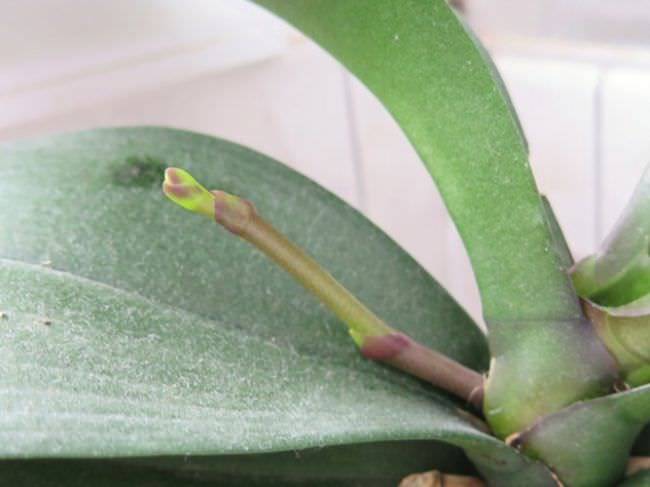

It is extremely important to choose the right time and stage of plant development to remove the peduncle. Pruning orchids is not always successful. In the presence of "dormant" buds, it is recommended to trim the peduncle slightly higher than them, which will be more correct to maintain the health of the plant.
Orchids can rest a little, and then start up new flower-bearing shoots again. This is done, as a rule, by almost all orchids adapted for growing and reproduction at home.
Possible problems and solutions
It happens that the peduncle either grows somehow "incorrectly", or is absent altogether.
There is no need to panic. We will deal with each of these cases and consider what a florist should do.
Emergence from the point of growth


The arrow grows from the point of growth - this happens with older phalaenopsisthat have experienced many flowering cycles. Another reason is the severe stress experienced by the plant. This is the very case when the owner of the plant does not need to do anything. Just take care of your pet as usual. Perhaps the arrow will still give buds or a baby.
The flower-bearing shoot broke
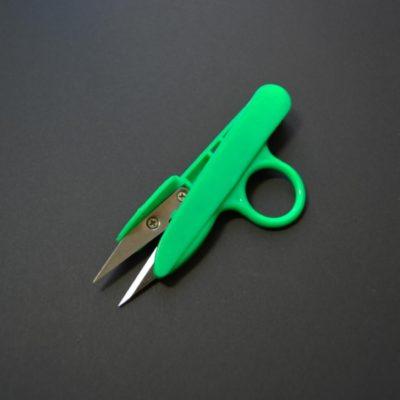

What to do? Just cut the peduncle to the kidney closest to the fracture site, and process the cut site - dust it with activated charcoal or cinnamon powder. In no case try to connect the fragments with tape or tape, as some inexperienced amateurs try to do, in the hope that their orchid will "grow together". This will only harm the plant, it may begin to dry out!
Not at all
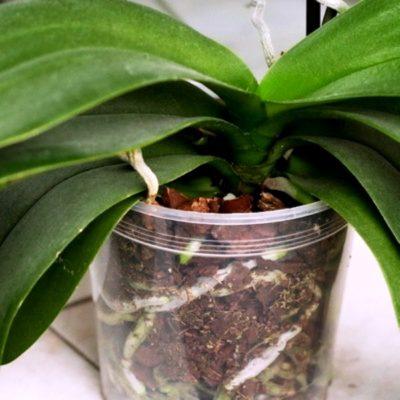

What should the owner of a "lazy" phalaenopsis do, how to grow a peduncle after all? If the plant is not in a hurry to pasture the arrow, you can give it a slight shake-up - place it in a darker than usual place and water it less often than before (of course, without bringing it to complete drought). If possible, at night it is better to lower the temperature for phalaenopsis by 5-6 degrees... Experienced florists make plants that sleep for even a year or more in this way.
Stopped in development
Esdi phalaenopsis stopped growing action algorithm:
- First of all, you should make sure that the orchid is healthy. Perhaps the reason is some kind of disease or pests.
- Analyze the conditions of keeping your phalaenopsis - is there enough light for it, is the mode of humidity and temperature observed, is there enough feeding for it?
- If, after treatment and the establishment of optimal conditions, the peduncle continues to remain frozen, the most reasonable thing is to take expectant tactics and observe the arrow. If it has not dried up, there is a chance that the green friend will someday please you with flowers.
You can find out more about the main reasons for the lack of flowering of phalaenopsis here, and from this article you will learn how to make an orchid bloom at home.
Stimulation of peduncle formation
If the flowering of the plant does not occur for a long time, then you can try to stimulate the distillation of a new shoot-peduncle. You can make an indoor orchid bloom again. It is not difficult to carry out such an event. With a few fairly simple tricks, you can stimulate an indoor orchid to release a new peduncle and bloom profusely.
However, it should be remembered that it is impossible to make a plant bloom without creating optimal temperature conditions and proper care. There are two ways to stimulate a houseplant to bloom again. As a rule, it is possible to stimulate the re-formation of the shoot-peduncle as a result of a little stress:
- artificially cause the plant to feel drought, minimizing as much as possible, and sometimes completely stopping watering after flowering;
- in the process of leaving, achieve re-flowering with sharp temperature fluctuations.


Both methods are well demonstrated in photographs with a detailed description of the technique. It is best to stimulate the flowering process in winter.
How to revive a dried peduncle
If the peduncle of the orchid dries up or has already dried up, then it should be carefully trimmed. It should be remembered that after the flowering stage, the orchid shoot-peduncle fades and can either dry out or continue to grow further. If the peduncle is slightly dry, but remains dense, then it is advisable not to cut it off for a while. It is imperative to wait until the stalk is completely dry.
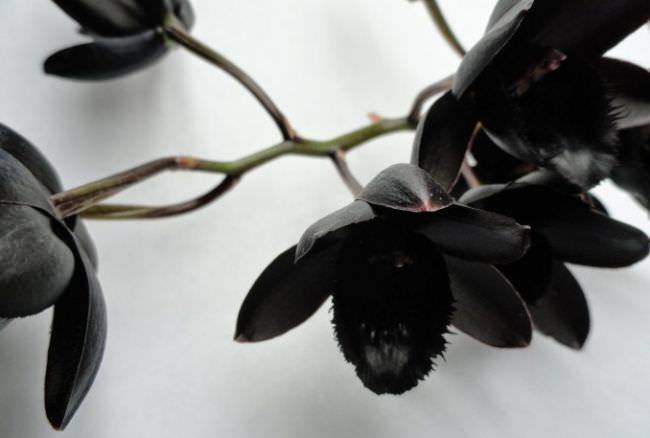

Florists often wonder what needs to be done with the peduncles from which the flower buds have fallen. These plants should be watched for some time. The main condition is compliance with proper care, and then, after a few months, the indoor orchid will bloom profusely again and will allow you to take bright and colorful photos.
How to grow an orchid from a peduncle
Undoubtedly, the simplest way of reproduction of the Phalaenopsis orchid is to transplant the lateral processes of the peduncle or the so-called “babies” with roots. With proper care, they grow very quickly and the transplanting process is absolutely simple. Already faded stems are also allowed to be used for the propagation of indoor orchids.
If the characteristics of the type of orchid plant allow propagation by a peduncle, then the standard method of grafting should be used. You should not be afraid to harm the health of the plant. Regardless of the state of the old peduncles, new shoots appear over time in orchids, and their growth is clearly visible in the photographs of these amazing plants.
podokonnik.
general information
The peduncle of an orchid is a shoot on which flowers are formed... One peduncle can have more than 50 buds! But this is in an adult and large orchid. The peduncle looks like a long and flexible stem, on which subsequently, after it grows to a certain length, orchid buds will begin to bloom. Some growers use the term "peduncle" in a narrower sense and understand by it the area of the stem of the plant, on which the flowers are directly located.
The main rule is that the peduncle always grows from the point of growth. Read more about the appearance and development of the peduncle here.
What to do to:
The arrow hasn't stopped developing?
So that the arrow grows and does not slow down in growth, you need to watch for the main parameters of care:
- Lighting - if it has decreased for natural reasons, it is necessary to introduce additional lighting with the help of illumination with special lamps for plants;
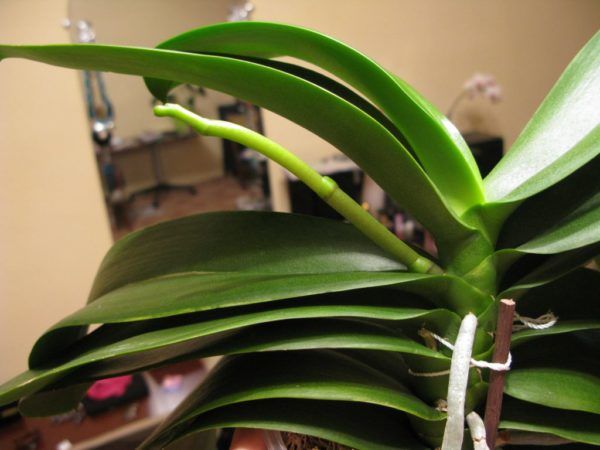

In order for the flowering arrow to grow well, all care conditions must be observed. - Watering - should be reduced compared to the usual regime. But do not dry the flower to a desert state;
- The temperature should be within the range required for the vegetative growth of the plant;
- You should not forget to apply fertilizers in time and according to all the rules.
Observing these rules, the plant will certainly delight its grower. beautiful tropical flowers.
Did the orchid release several peduncles at the same time?
How to make an orchid release several peduncles? More than 3 peduncles orchid will not release... More often, one shoot is released, on which flowers bloom.
But if the flower is old enough and has 8-10 leaves in its outlet, then there is a probability of 2-3 peduncles appearing.
But this is stress for the plant and sometimes after such an abundant flowering, there is a breakdown in orchid plants. But in our conditions, which are often created even by experienced florists, more than 2 peduncles do not appear on flowers.
Why is it important to determine what kind of new shoots a plant has?
Whatever appears in an orchid, for a grower who loves his plant, it is always a joy. A new rootlet, a baby, or a flower stalk promising a lush bloom is equally good. But it is still worth distinguishing the peduncle from other parts.
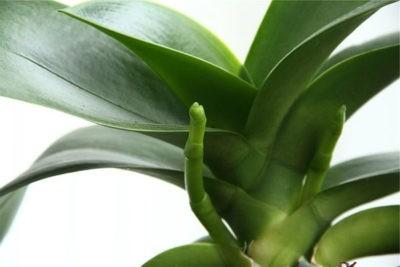

Thus, you will understand that the plant needs to be looked after more carefully. After all, the orchid during the flowering period requires special attention, periodically - feeding. The irrigation schedule is also changing.- It is not always a good idea to let the plant bloom. If it is not healthy, or has just gone through a difficult transplant (for example, due to rotten roots), the best solution is to cut the peduncle to give strength directly to growth.
- Nobody canceled a simple interest. And the orchid, as you know, is a leisurely flower, and it will take a long time to grow an incomprehensible shoot.
Step-by-step instructions: what to do in a certain situation?
Consider what to do if the peduncle that grows from the point of growth is broken or other possible cases:
- Grows from a point of growth. This happens if the phalaenopsis has already undergone many flowering cycles or experienced severe stress. In this case, you do not need to take any action, you just need to take care of the plant and, perhaps, buds or children will appear on the arrow.
- Broken. In this case, you need to cut the peduncle to the bud located closest to the fracture site and treat the cut site with crushed activated carbon, wood ash or cinnamon powder.
What does he look like?
Throughout its life cycle, the peduncle is greatly modified. It can be of two types.
New
It usually grows from the leaf axils - the place where the leaf comes close to the stem. It breaks through the leaf. The peduncle is usually flat in shape, but with a pointed tip that has a stepped shape... It is light green or deep green, growing upward or sideways, heading towards the sun.
Old
Gradually, the hatching peduncle will grow, turning into a long flexible stem, juicy and green. Then buds will bloom on it. Orchid flower stalks are very fragile and easy to break.... So it is better to tie the peduncle as it grows.
When the orchid fades, the peduncle will begin to change: it will change color to yellow or brown. Sometimes the color can even change to red or bright purple. After that, the old peduncle dries up and disappears. But it is better not to bring it to this, and cut off the peduncle immediately after the last flower wilts - this way you will save the plant's strength.
But sometimes it is difficult to understand if the flowering period has already ended.... Pay attention to the tip of the stalk. As long as it is green, this indicates that it is growing, it can increase in size and release new buds. But if the tip turns yellow, blackened or dried out, the flowering has come to an end.
To trim or not trim the peduncle - you can decide individually. The fact is that an old peduncle can bloom again or form a baby. On the other hand, old peduncles inhibit the development of new ones and generally weaken the plant. We discussed in more detail the issue of caring for a faded orchid here.
Difficulties in growing
In the process of growing an orchid, certain difficulties can arise. As a rule, they are associated with illiterate care and are easily solved if the flower is provided with normal conditions.
The most common problems:
- Stopping the growth of the peduncle. It is caused by a change in the location of the orchid, a lack of light or fertilizer, as well as cold air in the room.
- The peduncle that appeared from the point of growth.This is evidence of a mutation or unsuccessful crossing. This shoot blooms 1 time, but it can form children. The orchid will not be able to die from the stem that has grown in the center, but one should not hope for full flowering in the near future. How long to wait depends on the correct care. A complete rehabilitation usually takes from 5 months to six months.
- Drying of a young peduncle. An untimely transplant, a lack of nitrogen, potassium and phosphorus, and the absence of a difference between day and night temperatures lead to a sad result.
If the orchid does not form buds for a long time, the reason may lie at its age. Young specimens simply do not have time to build up a strong root system and go into the stage of bud and baby formation.
In caring for an orchid flower stalk, it is important to adhere to the measure. The plant loves stability, therefore, it is forbidden to move it to a new place and even more so to transplant it during flowering. If initially the exotic beauty was kept in the right conditions, it is enough to reduce watering and feeding when a bud appears. Then a scattering of lush flowers is provided, no worse than in the photo in magazines.
How to distinguish from a root?
A newly hatched peduncle can be easily confused with a root or baby. Focus on the following differences:


Peduncle:- It appears strictly from the neck of one of the freshly formed leaves.
- The tip is sharp and has a complex, stepped, cone-like shape.
- The shape of the tip is somewhat reminiscent of a closed beak.
- The shape of the peduncle itself is something flattened, rather flat.
- Stretches upward, less often sideways. The peduncle will go down later, under the weight of the formed buds, if it is not tied up in time.
- Root:
- It often grows outside, rather than in the leaf axils. It can grow from anywhere on the neck of the orchid, including from the middle of the leaf.
- The tip is bright, and then there is a light velamen.
- The shape of the tip is round, smooth, without scales.
- The shape of the kidney is uniformly rounded, conical.
- It can grow in any direction: up, sideways, but more often it tends to go down.
Watch a video about the difference between a peduncle and an orchid root:
Why is it important to distinguish the arrow from other parts?
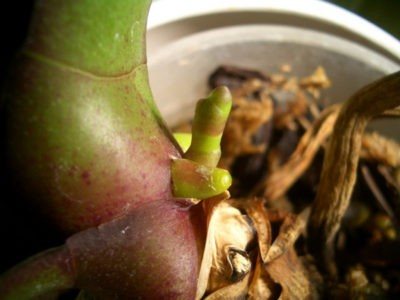

A new root, baby or peduncle portends a lush orchid bloom... Every flower lover should be able to distinguish a peduncle from other parts.
It is important that:
- Prevent flowering of a plant that has survived planting or illness. The shoot is cut to give strength for growth.
- Observe the development of the orchid.
- Understand how to properly care for an orchid during flowering.
If the plant simultaneously releases a healthy leaf and peduncle, it needs to be given the opportunity for further development.
What does it look like?
The peduncle changes greatly during the life cycle.... It can be of two types: just appeared and old. A young shoot grows from the place where the leaf comes close to the stem - from the bosom.
Such a peduncle is different:
- Rich light green or green color.
- Growing up or sideways towards the sun.
- A flat shape with a pointed end of a stepped shape.
On a young peduncle, you can see scales... From the moment the arrow begins to grow until the buds open, it will take about 2 months (what if the peduncle does not appear?).
Over time, the flowering arrow will develop and develop into a succulent, long and flexible stem. Buds will bloom on it.
Then the old bud dries up and falls off. It is advisable not to allow this, but to cut off the shoot after the last flower withers. Such a measure will help keep the plant strong.
Pay attention to the tip of the peduncle... It is often difficult to know if the flowering time has passed. If the bud is green, it can grow and bud. When the tip turns yellow, blackened or dried out, the flowering period is over.
Each grower decides for himself whether to cut or leave a peduncle. Old shoots weaken the plant and retard the development of new shoots. But the old peduncle can form babies or bloom again.Read more about what to do with a peduncle when the orchid has faded here.
How to distinguish from root and baby?
The newly appeared arrow on an orchid can easily be mistaken for a root or a baby.
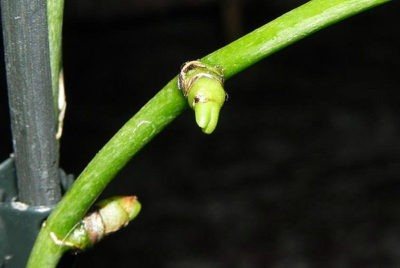

The peduncle has a number of distinctive features:
- Grows from the leaf axils of a fresh leaf.
- The sharp end of a complex stepped shape, like a cone. It resembles a closed beak.
- Pointed upward, sometimes sideways.
Down the peduncle will begin to descend only under the weight of the formed buds.
The root usually grows next to others - under the leaves at the base of the trunk. But it can appear in an unexpected place - to break through the leaves. The root has a rounded, smooth obtuse shape, no scales. As you grow, the difference between the tip and the rest of the root will become noticeable. It will be gray or gray-green, and the bright end will be light green or green. The root bud can grow in any direction, but is usually directed downward.
Peduncles and roots are slightly similar only in the initial stage of development.... Upon careful analysis, it becomes clear that they are completely different. There will be one fact to unite both parts of the plant - during germination, they seem to break through the leaf.
It is almost impossible to determine immediately whether a flower-bearing arrow or a baby has appeared on an orchid.
What a new baby looks like:
- Pointed up.
- The shape of the tip resembles an open beak.
- Grows in the place of flowering shoot.
The appearance of the baby (including the root one) is preceded by a complete absence of a growth point. Instead of a leaf, there is an arrow from the top. Moreover, the orchid is quite old - more than 6 years.
The baby has a number of differences from the peduncle:
- Very small scales that hardly develop during growth.
- After two weeks, the arrow grows and releases leaves.
- As the process develops, a depression forms in the middle.
The ability to immediately recognize new growths on an orchid will come with experience.
We offer you to watch a video on how to distinguish an orchid flower stalk from roots and children:
The presented "photos clearly demonstrate the modification of the orchid peduncle during life, as well as the difference between the flower-bearing shoot from the baby and the roots.
How is the peduncle different from the baby?
What does the baby look like:
- It grows in the place of the peduncle, next to the central vein of the leaf.
- The tip is shaped like an open beak.
- Pointed up.
It is almost impossible to distinguish a peduncle from a baby... It is necessary to wait until the process increases to at least 3 cm, then it will already be possible to understand something by the shape of the tip. The ability to instantly recognize what your orchid is growing comes with experience.
Watch a video about the difference between a baby and an orchid peduncle:
https://youtu.be/sVzocO3o4Vo
How to care?
After the release of the peduncle, the orchid can bloom for up to a year, gradually increasing it, and dissolving bud by bud. In another scenario, many flowers will open at the same time on the orchid, which will soon wither.
You can prolong flowering by competently caring for an orchid with a peduncle:


Do not allow the peduncle to remain in a draft. Cold and warm air is equally destructive for it, so put it aside from the battery and the air conditioner. An orchid that has stood in a draft for a day can throw off all flowers.- Once you have determined that this is a peduncle, and not a baby or a root, forget about transplanting for a while. While the flowering is in progress, you cannot touch the orchid. This is especially true of the capricious phalaenopsis in terms of transplantation.
- Fix the peduncle on a special holder, or tie it up in some way. Of course, in nature, nobody ties the flower stalks, and they fall down in a spectacular cascade. But at home, a loose peduncle is easy to damage. Especially if there are pets, always ready to try a novelty on the tooth.
- Provide adequate lighting for the stem. If there is not enough natural light, add additional lighting. Otherwise, it will reach for the light, grow behind it, and you will get a spiral instead of a straight arrow.In addition, only with full-fledged lighting will the peduncle develop normally: the more light, the faster it grows.
- Watering the orchid during the growth of the peduncle should be done in the same way. But with the beginning of flowering - reduce watering.
- If you have been feeding an orchid, continue feeding until the first flower is formed.
- If, after flowering, the peduncle begins to dry out quickly, cut it off with sharp scissors. You need to leave a small "stump". Sprinkle the place of the cut for disinfection with crushed charcoal or ground cinnamon. The remaining stump will be hollow inside. If water starts to stagnate in it, this will lead to decay of the trunk. It is better to immediately seal the hole tightly, for example with beeswax.
- If the peduncle remains green, do not rush to cut it off. Or trim the stem just above the third node to encourage re-flowering. But it is better not to use this advice if the plant is still young - it does not have enough strength for a baby or a new flowering.
Watch a video about caring for an orchid with a peduncle:
Care features
The period of growth of the peduncle is of great importance, because how you take care of the plant at this time depends on whether your phalaenopsis will please you with flowers, or you will only admire its foliage.
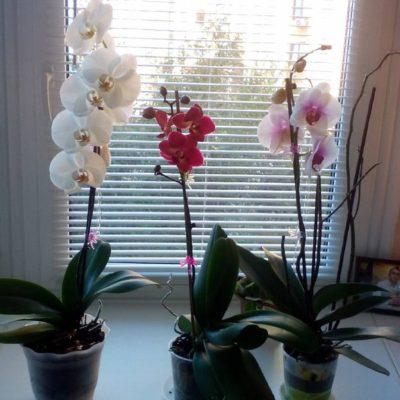

Adequate amount of light... In the autumn-winter period, natural light for the plant can be enough only in one case - if the window on which the pot stands faces the south side. In all other cases, additional lighting is required with a special phytolamp. Daylight hours for the phalaenopsis that released the shoot should last at least 12 hours.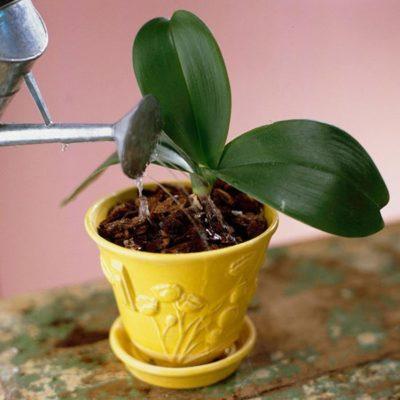

Optimal humidity regime. Phalaenopsis love moisture, and in the dry air of our apartments in winter it is not enough. Hence the recommendation: use a humidifier, especially since it is useful for people as well. Watering at this time is carried out as usual - as the substrate dries out in the pot. This parameter is individual, it depends on the temperature and humidity in the room.
Direct spraying is not required for a plant with a peduncle, and can even ruin a young sprout. Just place the pot deep in the group of flowers that you will spray, and the resulting water fog will be enough for the phalaenopsis.
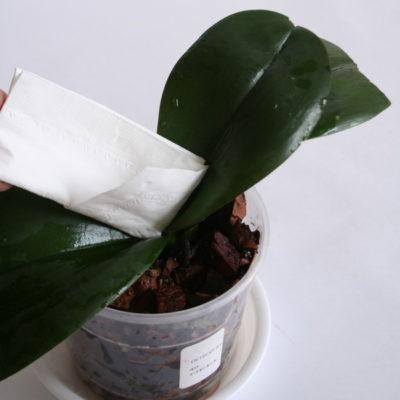

And finally, the correct plant feeding... Fertilizer during the period of flower stalk and subsequent budding should contain a large amount of phosphorus and potassium. It is highly desirable that this be a mineral fertilizer designed specifically for orchids. Top dressing is carried out no more than 1-2 times a month, and is suspended with the appearance of flowers.

